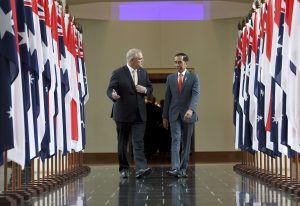It has been a little over a year since Australia and Indonesia signed their landmark trade deal, the Indonesia-Australia Comprehensive Economic Partnership Agreement (IA-CEPA). Throughout 2019 it seemed that the only things that could throw IA-CEPA’s ratification off track were protectionism or another diplomatic row. The agreement passed through the Australian Parliament in September 2019 and through Indonesia’s legislature in time for President Joko “Jokowi” Widodo’s official visit to Canberra in February.
For a trade deal that was over 10 years in the making and weathered challenges in bilateral relations, it was a historic result.
Now the ground beneath our feet has changed again. Government responses to the COVID-19 pandemic has curtailed many of the activities that underpin economic relations: international travel, face-to-face meetings, and large events. Policymakers and diplomats have duly turned their attention to managing the spread of the virus. The fallout from the pandemic threatens another critical phase of IA-CEPA: Its entry into force and implementation.
IA-CEPA does not immediately enter into force after ratification. There is another step. The treaty stipulates in its chapter on final provisions that it will enter into force 60 days after both countries exchange official, written notification that they have ratified the agreement through their respective domestic treaty-making processes. There is no date for IA-CEPA’s entry into force yet.
There is a real risk that IA-CEPA could get lost as diplomatic attention is focused elsewhere.
An element of IA-CEPA sensitive to the entry into force date are the Tariff Rate Quotas (TRQs), under which Indonesia agrees to allow in a specific volume or amount (quota) of a product tariff-free. Any additional exports beyond the quota are subject to a tariff.
An important feature of the TRQs is that they include a yearly percent increase in the volume that is allowed into Indonesia tariff-free. For example, the live cattle TRQ allows imports of 575,000 cattle at a 0 percent tariff in the first year after entry into force. This increases every year for the next six years. The sooner IA-CEPA goes into force, the sooner the clock for these increases starts.
If Australia and Indonesia can activate and use the TRQs as soon as possible, it will benefit both sides during this time of economic uncertainty.
Indonesia struggles to stabilize food prices and suffers from some of the highest prices in the region for staple goods. IA-CEPA can help address this problem. Its TRQs give Australian growers and live cattle exporters certainty about how much they can sell to Indonesia tariff-free. On the other side, Indonesia’s food security benefits from a reliable supply from a close neighbor. One challenge ahead will be continuing shipments amid travel restrictions. The live export industry is already encountering problems finding crews for their ships.
IA-CEPA also establishes cooperation mechanisms such as committees, working groups, Memoranda of Understanding (MoUs), and pilot projects. Most of these mechanisms require people-to-people exchanges, such as Indonesians coming to Australia for work training. The committees outlined in the chapter on institutional provisions are responsible for overseeing implementation of the agreement and are required to meet periodically to ensure both sides get the most from IA-CEPA. By diplomatic convention these meetings are usually held face-to-face, although there is nothing to preclude holding them by teleconference.
The exchanges required for these cooperation mechanisms will likely stall until the travel situation improves.
Furthermore, events and roadshows to encourage businesses to use IA-CEPA will be cancelled, unless appealing virtual alternatives can take their place. Building awareness of the agreement is essential. As Australia and Indonesia are under a “self-assessed” regime for import and export transactions, this means the responsibility is on the importer to activate the agreement. Customs authorities will not apply them automatically. Businesses need to be made aware of which of their products now have reduced tariffs under IA-CEPA so they can opt in to its benefits.
Another aim of IA-CEPA’s is to encourage Australian and Indonesian businesses to look at each other as profitable markets and investment destinations. Attracting new interest might have to wait. For Australians looking at building business contacts in Indonesia, the inability to visit is a challenging prospect in a culture that values establishing face-to-face business rapport.
If its entry-into-force date can be resolved soon, time is on IA-CEPA’s side. When IA-CEPA takes effect, the clock starts on the TRQ increases, committees will be obliged to meet within their respective timeframes, and businesses can start using the agreement. At this stage, the most the COVID-19 pandemic can do is slow things down. If 2020 is a write-off, an IA-CEPA that is in place will help us pick up where we left off when the situation stabilizes.
Kyle Springer is a senior analyst at the Perth USAsia Centre at the University of Western Australia.
































